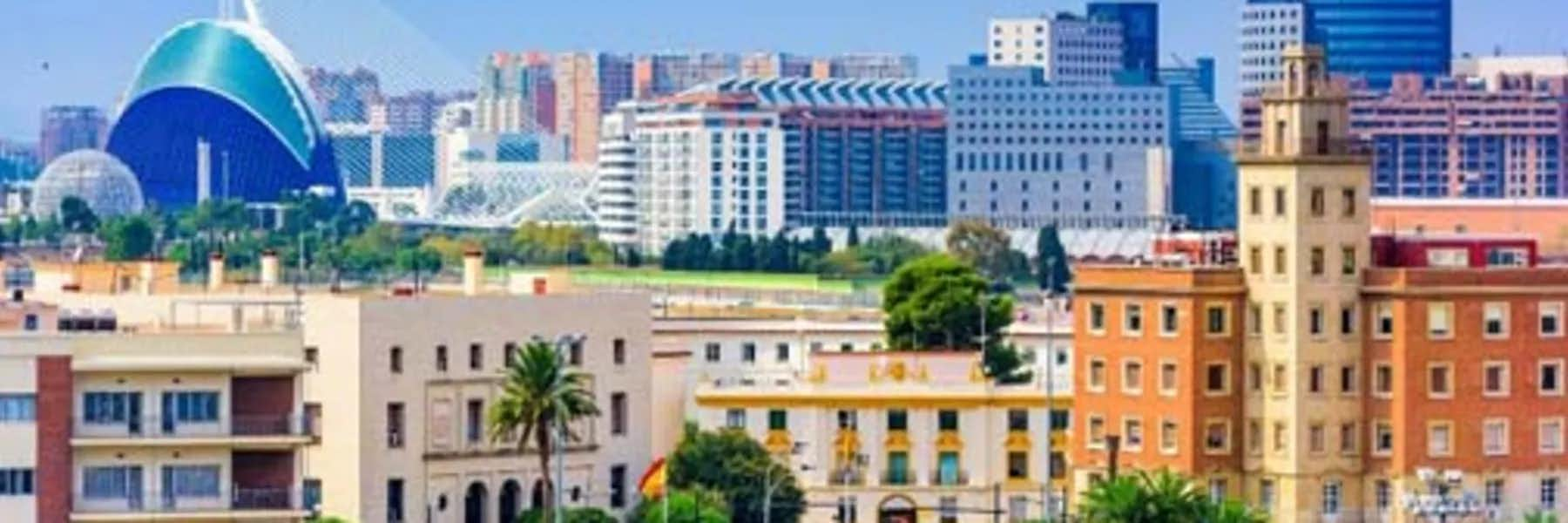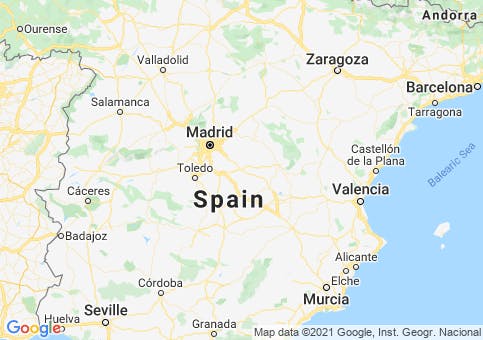At a sidewalk café in the Plaça de Sant Jaume, patrons chat over their cafés con leche or sit reading the paper, their dogs lying patiently at their feet. Trees shade this corner of the city from the summer sun, turning the café and its little square into oases of cool, civilized tranquility. Yet mere steps away is the busy Plaza de la Virgen, with its government buildings, spouting fountain, and camera-toting tourists from a dozen countries.
Valencia is the third largest city in Spain—a vibrant place where history and modernity blend seamlessly. Perched right along the peninsula’s beautiful Mediterranean coast, narrow streets wind and dance through breathtaking Gothic architecture, giving way to impressive open squares, dotted with high-quality restaurants serving up heaping pans of traditional paella. Golden sand beaches sprawl on the city outskirts, with balmy breezes and warm water.
The city was officially founded by the Romans in 138 B.C. who had conquered the early Iberian, Basque, and Celtic inhabitants. In 625, it was taken by Visigoths whose lands extended from Valencia to Andalusia.
Less than a hundred years after the fall of Roman rule, Valencia came under the control of the Umayyad Caliphate forces, led by General Tarik Ibn Ziyad. Under Muslim rule, Valencia’s water system was modernized, and its economy became more focused on agriculture. The city had typically Islamic narrow streets and alleys. Today the only traces of Moorish architecture are the baths of Abd Al-Malik, now called Baños del Almirante.
Between the 2nd and 15th centuries, Christian armies led by Spanish monarchs and the Catholic church reconquered Valencia and built many impressive structures that are still part of its modern urban landscape. The walled city, largely built during the Moorish led period, was destroyed between 1865 and 1868 during the Spanish Revolution.
One of Valencia’s most important ecological natural reserves, the Albufera Lagoon, has great cultural and historical significance for Spain. It is mentioned in ancient Roman texts as Nacarum Stagnus, in Arabic poems as Mirror of the Sun, and by Valencian writer Vicente Blasco Ibáñez who wrote about it in his 1902 novel, Cañas y barro.
Among them were the Crypt of the San Vicente Prison, the El Miguelete Cathedral, and the University of Valencia. The market square, a central landmark in the Ciudat Vella neighborhood, can be traced to the reconquista period of King James I. It remains an important place for Valencian commerce.
Get Your Free Spain Report Today!
Get Your Free Spain Report Today!
Learn more about the lower cost of living in Spain and other countries in our free daily postcard e-letter. Simply enter your email address below and we'll also send you a FREE REPORT — Live the Good Life in Sunny, Affordable Spain.

By submitting your email address, you will receive a free subscription to IL Postcards, Overseas Dream Home, The Untourist Daily and special offers from International Living and our affiliates. You can unsubscribe at any time, and we encourage you to read more about our Privacy Policy.
Traveling to Valencia
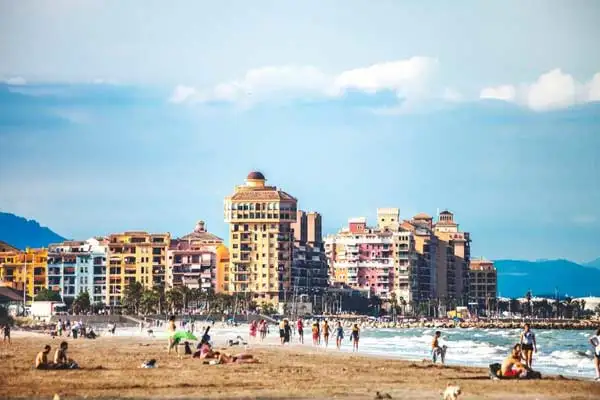
Valencia is definitely worth visiting, and an increasing number of foreigners are choosing to make it their home. You can fly from Madrid or Barcelona to Valencia’s Manises Airport or use the inter-city rail system. It’s easily accessible by various modes of public transport, and there are frequent trains going from Valencia to Madrid or Barcelona and vice versa. Most flights leaving Valencia are domestic, though there are international flights to Amsterdam, Greece, and Morocco.
The best time to visit Valencia is usually between May and October, when the temperature is at its highest and there is little rain. Valencia has a year-round Mediterranean climate and residents enjoy over 300 days of sun per year. The hottest month of the year is generally July, with a daily high of 32 C (89.6 F) and low of 22 C (71.6 F). In December, Valencians see cooler temperatures averaging between 7 C to 17 C (44.6 to 62.6 F). During October, rainfall can reach an average of 1.7 inches with dryer temperatures dominating from June to August.
Getting around in the city of Valencia is easy. Valencia has numerous foot and bike paths and a well-developed public transportation system that includes 60 bus lines, five metro lines, four tram lines, and six commuter trains. The system makes it easy for residents and visitors to travel to and from the airport, move from the city center to other trendy neighborhoods like Ruzafa, or visit the beaches, as well as surrounding communities.
Retire in Valencia
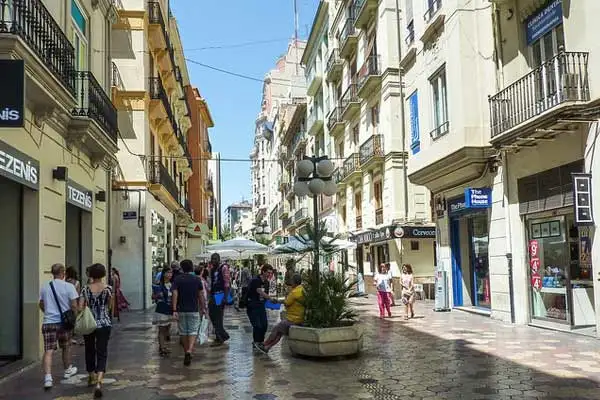
Valencia has emerged into a widely popular world destination for expats, largely because it boasts a high quality of life, while being affordable and safe. In recent years, however, rent prices have been steadily rising. A recent census by local authorities found that 16% of the city’s residents are foreigners, most of them EU citizens, though Latin Americans such as Colombians and Ecuadorians are living there in high numbers. There are fewer North Americans living in Valencia, though a growing number are showing an interest in settling in the city and connecting online.
The city of Valencia is branded as an intercultural city and local authorities approach tourism through a sustainable and inclusive lens that encourages participation and a sense of belonging from visitors. Valencian real estate is still affordable compared to North American cities like Toronto, Vancouver, and New York City. Most homes in Valencia are air conditioned and don’t require a heating system, but much of the city center’s structures are older and there are strict laws about modernizing the buildings due to their historical value.
The highest concentration of foreigners living in the city is in Ciutat Vella, or the Old City, though there are many who settle in Camins al Grau, Rascanya, and L’Olivereta. Visitors often stay in trendy areas like Ruzafa and El Cabanyal, which have a more low-key atmosphere. There are a few meet-up groups and language exchange events in Valencia where you can meet locals and other expats. The closer you get to the city center, the more challenging it will be to find affordable rental. Valencian owners prefer to rent to people who can prove they have a stable income from a Spanish source, making it difficult for digital nomads and residents without a permanent status to sign a rental agreement.
Foreigners can, however, purchase property in Valencia with the same rights as Spanish citizens. Spain encourages investments by foreign residents and non-residents. If you invest in a home worth more than 500,000 euros, you qualify for the Golden Visa. There are other paths to residency and obtaining a visa, including business owners, retirees, and digital nomads.
In 2023, Spain’s healthcare system ranked as the 8th best in the world. Valencia has many high-quality healthcare facilities and 23 of them are accredited by the Joint International Commission, the gold standard for hospital care. Among these are the General University Hospital of Valencia and La Fe University and Polytechnic Hospital. There are several private hospitals in Valencia, including Vithas Hospital, Hospital IMSKE, and Hospital NISA Valencia.
Expats living in Valencia can either obtain private health insurance from a local Spanish carrier or international company. If they qualify and are making contributions to Spain’s social security, they can get public coverage. Those not covered by insurance can choose out-of-pocket fees, though this isn’t recommended since many visa types require proof of coverage.
Lifestyle in Valencia
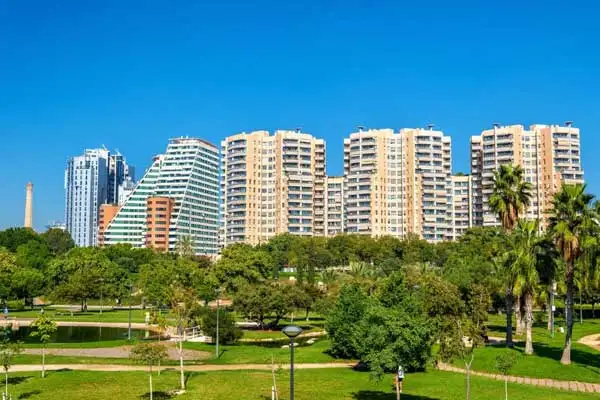
Valencian cultural life is closely tied to its historic structures and local legends. For example, local tour guides tell the story of the Church of Sant Nicolau, which is tied to Saint Nicholas himself, the inspiration behind Santa Claus. Gothic style cathedrals and baroque buildings, cobblestone streets, and modern museums are all part of the city’s tourist attractions. The Castillo de Santa Barbara is a rare example of Arabic culture. The 13th century castle served as a military post during the 19th century due to its strategic location and it still stands today.
The Valencian lifestyle also centers around nature. Many Valencians enjoy biking around the city, which has over 150 kilometers (93 miles) of bike lanes at their disposal. The city is very walkable, especially if you live in Ciutad Vella where most of the important landmarks are located near each other. Most neighborhoods have plenty of shops, cafés, and restaurants to choose from.
Like the rest of Spain, Valencians speak Spanish, though many residents of the region also speak Valenciano, a language similar to Catalonia’s Occitan but with strong French and Italian influences. During the dictatorship of Francisco Franco, Valenciano was suppressed, though it has since seen an upturn. Today, around 2.5 million people speak the language, and you can often read it on city billboards and signs, a symbol of Valencia’s unique regional identity.
Valencia is one of the safest in the country, boasting a safety index of 70 and a crime index of 29.8, which is much lower than cities like Milan, Nice, London (Canada), and Auckland (New Zealand). It’s very safe for travelers and residents, and overall, the risk is low even when walking alone at night. Taxi drivers in Valencia don’t generally overcharge although they appreciate a tip. Muggings are a rare occurrence in Valencia and the city is safe for solo women travelers, though you should avoid walking on dark deserted streets at night and never accept a drink from a stranger. Pick pocketing can occur in busy train stations, buses, and crowded areas and visitors should take precautions.
Best Things to Do in Valencia
Many people who visit or make Valencia their home love to spend time in Ciudat Vella, Ruzafa, and Alameda. El Cabanyal is emerging as an up-and-coming neighborhood due to its ideal location. It’s walking distance from many of the local beaches. Neighborhoods like Barrio del Cristo, Fuensanta, and Malvarrosa are less commonly visited by foreigners, mostly because there are less things to do. The city lifestyle is quintessentially Mediterranean, with easy access to many plant-based and seafood dishes, outdoor spaces for physical activity and relaxation, and an emphasis on social ties. Below are five recommendations for the best things to do in Valencia:
Walk Along El Cabanyal Beach and Sample the Tapas or Try the Paella
The stretch of coast running along Valencia is shallow and ideal for swimming, making these spots popular with families. There are also dozens of restaurants lined up along the walkway, offering countless options for eating out, from Mediterranean to Spanish and Italian. Spending the afternoon at Playa de Arenas or walking along El Cabanyal beach, you’ll find several tapas bars and a handful of international eateries, for example, an Argentinian restaurant called Asador El Portena. The most popular beaches, Playa del Cabanyal, Patacona Beach, and Malvarrosa Beach are pristine but tend to be a bit crowded during high tourist seasons.
Take a Biking Trip to La Huerta or L’Alburera
The Valencian terrain is mostly flat and you can easily rent a bicycle and take a ride to La Hurta agricultural area or L’Alburera natural park. The natural park is home to several indigenous species. During your visit, you’ll have a chance to learn about how regional authorities are working to preserve local fish populations like the Spanish toothcarp and samaruc. La Huerta is an agricultural garden traditionally focused on growing oranges, vegetables, and rice. Local growers offer tours and tastings in the garden.
Take a Walking Tour of the Old City
Physical activity is ranked high among the activities of Spanish citizens, and fitness is an important part of many Valencians’ lifestyle. There are a lot of green spaces, walking and biking trails, and natural parks available year-round thanks to the mild climate. You can wander around and find a café to have breakfast or shop at a bakery. I recommend stopping by Horno San Bartholome to try the orange muffins and the masa madre bread. Afterwards, take a guided walking tour of the Old City, shop at Mercado Central and stop to look at its ceiling.
Celebrate Las Fallas Festival
Valencians celebrate Las Fallas Festival every March to commemorate the arrival of spring. Artists build fallas monuments that represent large colorful works of art meant to satirize current political events and social topics. Like Valencia, the celebration is family friendly. Falleros and falleras, organize the event and dress in expensive clothes and jewelry. The city population swells to three times its size during Las Fallas festival and is one of the largest street parties in Europe and has an impressive light display in the Ruzafa neighborhood. The most important elements of Las Fallas are the ninot exhibition (children’s category) and La desperta, a ceremony that symbolizes the ‘awakening’ of festival goers and involves the constant sound of firecrackers. Las Fallas Festival was recognized by UNESCO as an intangible world heritage site in 2016.
Visit the City of Arts and Science
The City of Arts and Science Museum (Ciutad de las Artes y las Ciencias) is a beautiful modern architectural design and offers great photo opportunities. The museum is family friendly and has many structures to visit. The opera house, El Palau de les Artes Reina Sofia is a performing art center designed by Valencian architect Santiago Calatrava and a popular venue for music, dance, and theater performances. The design is symbolic of marine life and a passageway to the Mediterranean gardens of the museum city. The sprawling complex also includes the Principe Felipe Science Museum and the Oceanografic aquarium.
Cost of Living in Valencia
Valencia has managed to keep the cost of food and other products low compared to most places in the Americas, in part thanks to the EU trade agreement, which means that products imported from other EU countries are not subject to tariffs. Dining out, groceries, shopping, and entertainment are less expensive, contributing to an overall lower cost of living. Apartment rentals in Valencia are less expensive than many North American cities, although the price is gradually rising, in part due to the high demand for certain neighborhoods.
Transportation in Valencia is generally low cost. You can purchase a single bus ticket for 1.5 euros or a 10-ride SUMA card for 10 trips at 10 euros. A bus will take you to the Albufera Natural Park where you can take a board ride on the Lagoon. App-based car rides from Uber and Cabify, and local taxi services are waiting at the airport, and a trip will typically cost around €20 for a 20-minute ride. Here is an average budget for monthly expenses based on a couple living in the city center of Valencia. Lifestyle, neighborhoods, and housing requirements can vary widely:
| Expense | US $ |
| Rent (furnished, two-bedroom apartment/home) | 1,350 |
| Electricity, Water, Heating/Cooling | 125 |
| Internet | 30 |
| Cellphones | 30 |
| Healthcare and Insurance | 250 |
| Transportation (SUMA pass, Taxis) | 50 |
| Groceries | 500 |
| Entertainment | 200 |
| Miscellaneous | 100 |
| Monthly Total: | $2,635 |
Note: Private health insurance rates can vary greatly depending on age and existing health conditions.
